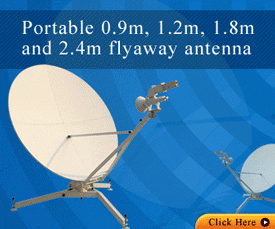How to obtain best gain from offset VSAT antenna
Are you are using an offset reflector made from glass or polyester reinforced plastic with a long heavily loaded feed arm supported by two side struts? The surface profile of the dish may be distorted, with the sides pulled forward and the bottom pushed back. This can cause seriously low gain, as bad as -5 dB due to the dish having two spaced focal regions, one in the horizontal and one in the vertical plane.
This note is based on experience with a single piece, 1.2m antenna with a long feed arm (f/d=0.8) at 30 deg elevation and with a heavy ORU system. It may be applicable to other offset antennas with 1, 2, 3 or 4 panels. It is not applicable to axi-symmetric (feed in the middle) antennas. See axiflat.htm for advice on how to align panel edges on axi-symmetric antennas, or any antenna.
To measure your dish flatness:
Preparation: Record date and time in a log book plus present receive quality, e.g. C/N or Eb/No. Turn off the transmitter. Use two lengths of fishing line, some adhesive tape and short measuring rule.
Method: Put the first fishing line tightly up and down the centre of the dish. Attach from top to bottom across the front of the dish, using plenty of sticky tape on the back and make sure it is tight. At the bottom the line may be just to the side of the feed arm but must lie flat on the front edge. Put the second fishing line horizontally across the middle of the dish, attaching it at either side just above where the support struts attach. Make sure it is tight.
Measure the distance (if any) between the two fishing lines where they cross in the centre. Record the distance in mm, together with date and time in a log book.
If you are operating at 6 GHz the wavelength is 300/6 mm = 50mm
If you are operating at 14 GHz the wavelength is 300/14 mm = 21mm
The accuracy required varies according to how much obtaining the best performance matters to you. Somewhere between 1/10 and 1/16 of a wavelength is about right.
If you are operating at 6 GHz the gap should be less than 50/16 = 3mm
If you are operating at 14 GHz the gap should be less than 21/16 = 1mm
If your measurement is much more than these figures there is room for improvement.
Adjusting the reflector to flatness:
Preparation: You need tools to loosen and retighten the elevation adjuster and other nuts and bolts, particularly those at the bottom back end of the feed arm. You need some method for peaking up the antenna.
First deal with the problem of the feed arm pushing the bottom edge of the dish backwards. Behind the dish at the bottom there is a steel spine structure and it is important that this takes the full load of the feed arm rather than the reflector itself. If there is a reference screw through the feed arm and into the dish edge, remove it temporarily and see what happens. Adjust the screws joining the feed arm to the spine until all the weight is taken by the spine and the hole in the feed arm happens to align with the reference hole in the dish edge. It helps to have an assistant to pull the feed/ORU assembly forwards and upwards. It should then be possible to drop the reference screw into position with no force. The screw makes the feed to reflector distance correct.
Re-measure the flatness error. Hopefully it will have dramatically improved and you may well be happy. Peak the antenna in elevation and re-measure C/N or Eb/No. Turn the transmitter on with low drive. Set the transmit power with the assistance of the far end and ask for a reduced space segment tariff. (3 dB reduction might halve your costs or double your traffic capacity using the same kit). Please send me a cheque (payable to Satellite Signals Ltd, address via email) for 50% of your first year's savings!
Residual error and notes for the perfectionist
Residual error is likely due to the sides being pulled forwards. I can't find an easy cure for this. Turn the transmitter off before working on the antenna.
One possibility is to deliberately misalign the reference hole so that insertion of the reference screw forces the bottom of the dish forwards somewhat. The logic is that the sides are pulled forwards and adding the bottom forced forwards as well, achieves a flatter surface but with the focal length reduced slightly.
Alternatively, if appearance does not matter, but perfection does, then an improvised length of girder across the back of the full diameter of the dish plus a few inches, attached to the feed strut attachment points either side at the back by tighteners is an ugly option, but does allow the dish to be pulled flat exactly. Very large size steel cored cable ties are useful. Screw turnbuckles might also do the job if you can devise some good end fittings and secure the screws for the long term. If you do attach a girder across the back, add extra fixings in the middle to prevent the girder coming apart in a hurricane, for safety.
Finally make sure everything is tight and safe and don't fall down the ladder!.

